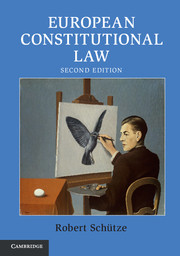Book contents
- Frontmatter
- Dedication
- Summary Contents
- Contents
- List of Illustrations
- List of Tables
- List of Cases
- List of Secondary Law
- Table of Equivalents
- List of Abbreviations
- Acknowledgements
- Introduction: European Constitutional Law
- Part I Constitutional Foundations
- Part II Governmental Powers
- Appendices
- 1 How to Find the EU Treaties
- 2 How to Find (and Read) EU Secondary Law
- 3 How to Find (and Read) EU Court Judgments
- 4 How to Find EU Academic Resources
- Index
3 - How to Find (and Read) EU Court Judgments
from Appendices
- Frontmatter
- Dedication
- Summary Contents
- Contents
- List of Illustrations
- List of Tables
- List of Cases
- List of Secondary Law
- Table of Equivalents
- List of Abbreviations
- Acknowledgements
- Introduction: European Constitutional Law
- Part I Constitutional Foundations
- Part II Governmental Powers
- Appendices
- 1 How to Find the EU Treaties
- 2 How to Find (and Read) EU Secondary Law
- 3 How to Find (and Read) EU Court Judgments
- 4 How to Find EU Academic Resources
- Index
Summary
All EU cases are traditionally identified by a number/year figure that is followed by the names of the parties. Cases before the Court of Justice are preceded by a C-, while cases decided before the General Court are preceded by a T- (for the French ‘Tribunal’). The Civil Service Tribunal prefixes its cases with an F- (for the French ‘Fonction publique’).
In the past, all judgments of all EU Courts were published in paper form in the purple-bound ‘European Court Reports’ (ECR). Cases decided by the Court of Justice were published in the ECR-I series; cases decided by the General Court were published in the ECR-II series, while cases decided by the Civil Service Tribunal were published in the ECR-SC series. However, as of 2012, the entire Court of Justice of the European Union has decided to go ‘paperless’ and now publishes its judgments only electronically. The two principal websites here are the Court's own curia website (http://curia.europa.eu/jcms/jcms/j_6/), and the Union's general EU Lex website (http://eur-lex.europa.eu/homepage.html). For judgments referred to in the main text of this book, the easiest way is however to go to www.schutze.eu, which contains the ‘Lisbon’ version of all classic EU Court judgments.
Once upon a time, judgments issued by the European Court of Justice were – to paraphrase Hobbes – ‘nasty, brutish and short’. Their shortness was partly due to a structural division the Court made between the ‘Issues of Fact and of Law’ (or later: ‘Report for the Hearing’) – which set out the facts, procedure and the arguments of the parties – and the ‘Grounds of Judgment’. Only the latter constituted the judgment sensu stricto and was often very short indeed. For the Court originally tried to adopt the ‘French’ judicial ideal of trying to put the entire judgment into a single ‘sentence’! A judgment like Van Gend en Loos contains about 2000 words – not more than an undergraduate essay.
This world of short judgments is – sadly or not – gone. A typical judgment issued today will, on average, be four to five times as long as Van Gend.
- Type
- Chapter
- Information
- European Constitutional Law , pp. 479 - 482Publisher: Cambridge University PressPrint publication year: 2015



